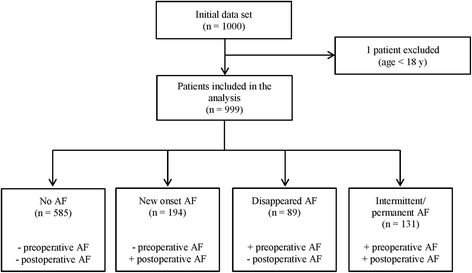Clinical significance and risk factors for new onset and recurring atrial fibrillation following cardiac surgery - a retrospective data analysis
- PMID: 29197340
- PMCID: PMC5712135
- DOI: 10.1186/s12871-017-0455-7
Clinical significance and risk factors for new onset and recurring atrial fibrillation following cardiac surgery - a retrospective data analysis
Abstract
Background: Although mortality after cardiac surgery has significantly decreased in the last decade, patients still experience clinically relevant postoperative complications. Among others, atrial fibrillation (AF) is a common consequence of cardiac surgery, which is associated with prolonged hospitalization and increased mortality.
Methods: We retrospectively analyzed data from patients who underwent coronary artery bypass grafting, valve surgery or a combination of both at the University Hospital Muenster between April 2014 and July 2015. We evaluated the incidence of new onset and intermittent/permanent AF (patients with pre- and postoperative AF). Furthermore, we investigated the impact of postoperative AF on clinical outcomes and evaluated potential risk factors.
Results: In total, 999 patients were included in the analysis. New onset AF occurred in 24.9% of the patients and the incidence of intermittent/permanent AF was 59.5%. Both types of postoperative AF were associated with prolonged ICU length of stay (median increase approx. 2 days) and duration of mechanical ventilation (median increase 1 h). Additionally, new onset AF patients had a higher rate of dialysis and hospital mortality and more positive fluid balance on the day of surgery and postoperative days 1 and 2. In a multiple logistic regression model, advanced age (odds ratio (OR) = 1.448 per decade increase, p < 0.0001), a combination of CABG and valve surgery (OR = 1.711, p = 0.047), higher C-reactive protein (OR = 1.06 per unit increase, p < 0.0001) and creatinine plasma concentration (OR = 1.287 per unit increase, p = 0.032) significantly predicted new onset AF. Higher Horowitz index values were associated with a reduced risk (OR = 0.996 per unit increase, p = 0.012). In a separate model, higher plasma creatinine concentration (OR = 2.125 per unit increase, p = 0.022) was a significant risk factor for intermittent/permanent AF whereas higher plasma phosphate concentration (OR = 0.522 per unit increase, p = 0.003) indicated reduced occurrence of this arrhythmia.
Conclusions: New onset and intermittent/permanent AF are associated with adverse clinical outcomes of elective cardiac surgery patients. Different risk factors implicated in postoperative AF suggest different mechanisms might be involved in its pathogenesis. Customized clinical management protocols seem to be warranted for a higher success rate of prevention and treatment of postoperative AF.
Keywords: C-reactive protein; CABG; Inflammation; Phosphate; Positive fluid balance; Postoperative atrial fibrillation; Valve surgery.
Conflict of interest statement
Ethics approval and consent to participate
The study was approved by the ethics committee of the Medical Association Westfalen-Lippe and the University of Münster (Approval No. 2015–487-f-S). The need for informed consent was waived due to the non-interventional, retrospective design of the study.
Consent for publication
Not applicable
Competing interests
HT, SH, SB, VF, JS and MW are employees of Fresenius Kabi Deutschland GmbH. All authors declare that they have no competing interests.
Publisher’s Note
Springer Nature remains neutral with regard to jurisdictional claims in published maps and institutional affiliations.
Figures




References
MeSH terms
LinkOut - more resources
Full Text Sources
Other Literature Sources
Medical
Research Materials
Miscellaneous

